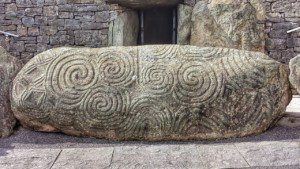
The Boyne passes in a loop around Newgrange which is the modern name for the ancient site of Brugh na Boinne, the House of the Boyne. It is one of the most remarkable megalithic monuments in the whole of Europe, being nothing less than a measuring instrument of time itself. Because of its proximity to Tara, Newgrange along with its sister sites Knowth and Dowth, were presumed to be a kind of ‘Valley of the Kings’ for the Irish dynasties. This idea is now overthrown because, although the mounds were used for burial purposes, this was a later use of what was once a series of time-mounds administered by the Irish druids and their forebears.
Newgrange, although known extensively in ancient Irish texts, was not rediscovered until 1699, 9 years after the downfall of the Stuart cause at the disastrous Battle of the Boyne when William of Orange was triumphant. This is perhaps mythically significant, since Brugh na Boinne changed hands at the beginning of its mythology from Elcmar to Oengus mac ind Dha og (Angus mac Og), just as the Stuart King, James II ceded place to the new dynasty of Orange.
Another name for Newgrange indicates its true nature – Grian Uaigh or ‘Cave of the Sun.’ Martin Brennan has decoded the hieroglyphs which cover Newgrange; he has unlocked the saying of Amairgen, the chief poet of the Milesians:
Who but I knows the secret of the unhewn dolmen? Who is he who announceth the ages of the Moon? And who, the place where falleth the Sunset? -Arnairgen Leabhar Gabala
Working intuitively from the symbols insribed on the stones, Brennan has discovered that the symbols are not, as ignorant archaeologists have assumed, ‘megalithic doodles’, but meaningful and very accurate records of lunations, movements of the sun and the planets, and that they constitute a calendar which the Irish would have used on a daily basis. They are so accurate that seconds can be calculated from the stones.
Newgrange is aligned to the mid-winter sunrise so that the beam of the rising sun falls directly into the chamber. Its sister sites, Knowth and Dowth were also used as alignment monuments and calendars: Knowth is aligned to the Vernal and Autumnal Equinoxes while Dowth is aligned to the mid-summer sunrise – thus giving an accurate reckoning of the four sun-markers of the year. The Celtic festivals would have been determined from the lunation cycle which is visible to careful observers of the moon, each festival being kept upon the full-moon. The twelve stones surrounding Newgrange point to the solsticial and equinoctial sunrises and sunsets, and also align to Knowth and Dowth. These other two sites each have myths attached to them which are significant. Knowth is associated with Englec, the daughter of Elcmar – the original owner of the Brugh. She was the mistress of Oengus. Dowth is also called Sidhe Breasil after the druid of that name who attempted to build a tower to heaven. He contracted men to work for a mere day to help him and his sister druid. They made a spell so that the sun should not set until the mound was built. Breasil committed incest with her, thus causing the sun to set. The sister remarked, ‘Dubud (Darkness) shall be the name of that place forever.’ Dowth, being aligned to the midsummer-sunrise is thus significantly associated with darkness, for midsummer marks the failing of the light towards winter. The mid-winter sunset illuminates one of the chambers also, thus making it also a monument to the return of the light.